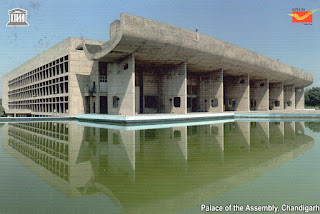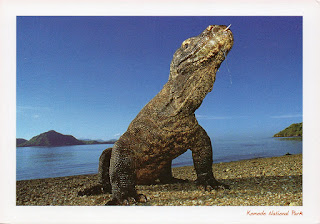This site is located in 7 countries of 3 different continents! I was already once in the Immeuble Clarté and three times in the "Petite Villa au bord du lac Léman", both in Switzerland, and only at third time I found postcards of the Villa
This small detached house, designed for Le Corbusier’s parents, was built in 1923-24 from plans drawn up by Le Corbusier and by his cousin, Pierre Jeanneret fully illustrate the ideas for which their authors were already renowned at that time. The Villa “Le Lac” foreshadows three of the “five points for a new architecture”: the use of the roof as a sun deck or garden, the open plan and the ribbon window.
The house, as it stands today, has remained quite true to the original plan. - in: http://www.villalelac.ch/en/history.html
 |
| The Architectural Work of Le Corbusier |
Chosen from the work of Le Corbusier, the 17 sites comprising this transnational serial property are spread over seven countries and are a testimonial to the invention of a new architectural language that made a break with the past. They were built over a period of a half-century, in the course of what Le Corbusier described as “patient research”. (...) These masterpieces of creative genius also attest to the internationalization of architectural practice across the planet. - in: https://whc.unesco.org/en/list/1321
 |
| Villa Le Lac |
This small detached house, designed for Le Corbusier’s parents, was built in 1923-24 from plans drawn up by Le Corbusier and by his cousin, Pierre Jeanneret fully illustrate the ideas for which their authors were already renowned at that time. The Villa “Le Lac” foreshadows three of the “five points for a new architecture”: the use of the roof as a sun deck or garden, the open plan and the ribbon window.
The house, as it stands today, has remained quite true to the original plan. - in: http://www.villalelac.ch/en/history.html
 |
| Maison Guiette |
This postcard was sent by Hanko
Maison Guiette also known as Les Peupliers, is a house in Antwerp, Belgium, designed by Le Corbusier in 1926 and built in 1927. It was the studio and living quarters of René Guiette, a painter and art critic. One of the Franco-Swiss architect's lesser-known works, it is an early example of the International Style. - in: wikipedia
 |
| Weissenhof Estate |
This postcard was sent by Steffi
The Weissenhof Estate (or Weissenhof Settlement; in German Weißenhofsiedlung) is a housing estate built for exhibition in Stuttgart in 1927. It was an international showcase of what later became known as the International style of modern architecture. - in: wikipedia
 |
| Studio-Apartment in the Molitor Building |
Built between 1931 and 1934, the Studio-Apartment at the top of the Molitor Building in Paris is a compact, carefully considered evocation of his “Five Points of New Architecture” — support columns, gardens on roofs, open floors, façades that are floating, and windows that are horizontal for optimal light.
Le Corbusier lived here until his death in 1965, and it’s preserved the way he left it by the Fondation Le Corbusier. - in: http://www.atlasobscura.com/places/le-corbusier-s-studio-apartment
 |
| Chapel Notre Dame du Haut |
Notre Dame du Haut (French: Chapelle Notre-Dame-du-Haut de Ronchamp) is a Roman Catholic chapel in Ronchamp, France. Built in 1954, it is one of the finest examples of the architecture of Franco-Swiss architect Le Corbusier and one of the most important examples of twentieth-century religious architecture. The chapel is a working religious building and is under the guardianship of the private foundation Association de l’Œuvre de Notre-Dame du Haut. - in: wikipedia
 |
| Palace of Assembly, Chandigarh |
This postcard was sent by Prashant Alex
Palace of Assembly is a legislative assembly designed by noted architect Le Corbusier and located in Chandigarh, build around 1950s India. It is part of the The Capitol Complex, which comprises three buildings — Legislative Assembly, Secretariat and High Court. This building was designated as a UNESCO World Heritage Site in 2016. - in: wikipedia
 |
| National Museum of Western Art |
The National Museum of Western Art is the premier public art gallery in Japan specializing in art from the Western tradition.
The Main Building was designed by the Swiss architect Charles-Edouard Jeanneret-Gris (1887–1965), who is more popularly known as Le Corbusier. It is the only representative example of his work in the Far East; and the New York Times review of its opening suggested that the building itself presented an "artistic significance and beauty" which rivaled the paintings inside. - in: wikipedia
I'm still missing a postcard from Argentina, but I have one that shows the seven countries
The work of Le Corbusier inscribed (in red what I have individually):
- Maisons La Roche et Jeanneret - France
- Petite villa au bord du lac Léman - Switzerland
- Cité Frugès - France
- Maison Guiete - Belgium
- Maisons de la Weissenhof-Siedlung - Germany
- Villa Savoye et loge du jardiner - France
- Immeuble Clarté - Switzerland
- Immeuble locatif à la Porte Molitor - France
- Unité d’habitation Marseille - France
- La Manufacture à Saint- Dié - France
- Maison du docteur Curutchet - Argentina
- Chapelle Notre-Dame-du-Haut de Ronchamp - France
- Cabanon de Le Corbusier - France
- Complexe du Capitole - India
- Couvent Sainte-Marie-de-la-Tourette - France
- Musée National des Beaux-Arts de l’Occident - Japan
- Maison de la Culture de Firminy - France

























